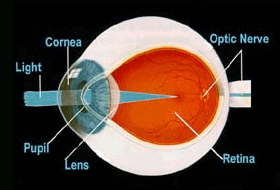How Does The Human Eye Work?
The individual components of the eye work in a manner similar to a camera. Each part plays a vital role in providing clear vision. So think of the eye as a camera with the cornea, behaving much like a lens cover. As the eye’s main focusing element, the cornea takes widely diverging rays of light and bends them through the pupil, the dark, round opening in the center of the colored iris. The iris and pupil act like the aperture of a camera.


Next in line is the lens which acts like the lens in a camera, helping to focus light to the back of the eye. Note that the lens is the part which becomes cloudy and is removed during cataract surgery to be replaced by an artificial implant nowadays.
The very back of the eye is lined with a layer called the retina which acts very much like the film of the camera. The retina is a membrane containing photoreceptor nerve cells that lines the inside back wall of the eye. The photoreceptor nerve cells of the retina change the light rays into electrical impulses and send them through the optic nerve to the brain where an image is perceived. The center 10% of the retina is called the macula. This is responsible for your sharp vision, your reading vision. The peripheral retina is responsible for the peripheral vision. As with the camera, if the “film” is bad in the eye (i.e. the retina), no matter how good the rest of the eye is, you will not get a good picture.
The human eye is remarkable. It accommodates to changing lighting conditions and focuses light rays originating from various distances from the eye. When all of the components of the eye function properly, light is converted to impulses and conveyed to the brain where an image is perceived.